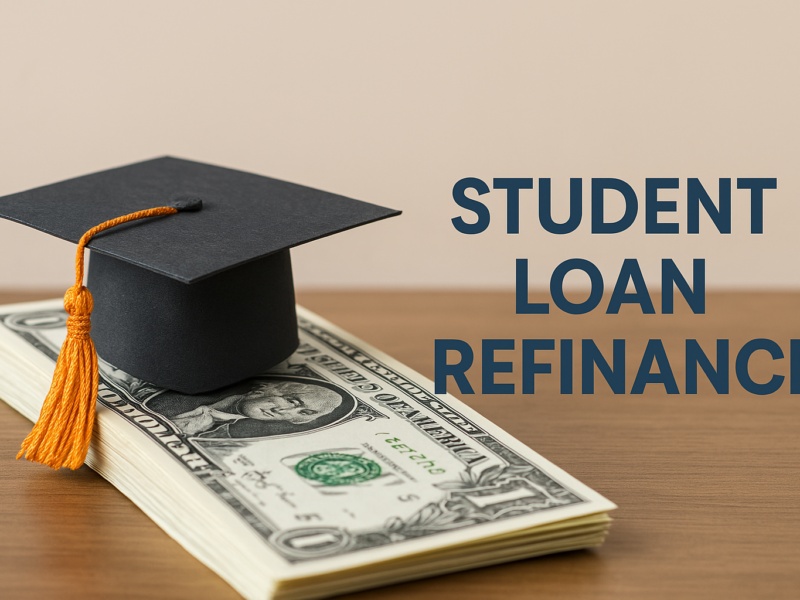Student loan refinance is a smart financial decision that can offer significant benefits to borrowers looking to reduce their monthly payments, save on interest, or even pay off their debt more quickly. Whether you’re a recent graduate burdened with loans or someone looking to take control of your financial future, refinancing can help you achieve your goals. But how does student loan refinance work, and what do you need to know before making the leap? In this comprehensive guide, we’ll explore everything from the basics to the more nuanced factors that will help you make an informed decision.
What is Student Loan Refinance?
Student loan refinancing is the process of taking out a new loan to pay off one or more existing student loans. This new loan typically comes with a different interest rate, which may be lower than your original loan, depending on your creditworthiness, income, and the terms you secure. The goal is to save money on interest and simplify your loan payments by consolidating them into a single loan with better terms.
Refinancing can be an attractive option if you have private student loans or federal loans and you’re looking to reduce the interest rate or change your repayment terms. It’s important to note that refinancing federal student loans into a private loan means losing federal loan protections, such as income-driven repayment plans and loan forgiveness programs. Therefore, refinancing is not always the right choice for everyone.
Why Consider Student Loan Refinancing?
- Lower Interest Rates One of the primary reasons borrowers refinance their student loans is to secure a lower interest rate. If your credit score has improved since you first took out your loan, refinancing can potentially lower your interest rate and reduce the total amount of money you’ll pay over the life of the loan. Even a small decrease in your interest rate can save you hundreds or even thousands of dollars.
- Lower Monthly Payments If you’re struggling with high monthly payments, refinancing may allow you to extend your loan term, which could lower your monthly payment. This can free up some cash flow for other financial priorities, such as building an emergency fund or saving for retirement. However, keep in mind that extending the loan term may increase the total interest paid over the life of the loan.
- Simplify Your Finances If you have multiple student loans, refinancing can consolidate them into one loan with one monthly payment. This can make managing your debt easier and less stressful, as you won’t have to worry about keeping track of multiple due dates and loan servicers.
- Switch to a Fixed or Variable Rate When refinancing, you often have the option to choose between a fixed or variable interest rate. Fixed rates remain the same throughout the life of the loan, while variable rates can fluctuate based on market conditions. If you prefer stability, a fixed-rate loan might be the best option for you. However, if you’re comfortable with some risk and want to take advantage of potential future rate drops, a variable-rate loan may offer lower initial rates.
The Pros and Cons of Refinancing Student Loans
Pros:
- Reduced Interest Rates: The most appealing benefit of refinancing is the potential for a lower interest rate, which can save you money in the long run.
- Improved Cash Flow: By extending the loan term or reducing the interest rate, you may be able to lower your monthly payments and ease your financial burden.
- Simplification: Refinancing can simplify your loan payments by consolidating multiple loans into one.
- Flexibility: You may be able to choose between a fixed or variable interest rate based on your preferences.
Cons:
- Loss of Federal Protections: Refinancing federal loans into a private loan means you lose federal benefits, such as income-driven repayment plans, deferment options, and loan forgiveness programs.
- Eligibility Requirements: Not everyone is eligible for refinancing, especially if you have poor credit or a low income. Private lenders typically have stricter eligibility criteria.
- Potential Higher Rates: If you have a low credit score, refinancing may result in a higher interest rate than your original loan, which could increase the total cost of the loan.
How to Refinance Your Student Loans
Refinancing student loans is a relatively straightforward process, but there are several steps you need to follow to ensure you get the best deal:
- Check Your Credit Score: Your credit score plays a significant role in the interest rate you’ll receive when refinancing. Most lenders require a credit score of at least 650 to qualify for refinancing, but the higher your score, the better the rate you’ll be offered.
- Compare Lenders: Shop around and compare offers from multiple lenders to find the best rates and terms. Be sure to look at both private banks and online lenders, as rates and terms can vary widely between them.
- Determine Your Loan Term: Decide on the length of your new loan term. While longer loan terms can reduce your monthly payment, they may increase the total interest you pay. On the other hand, shorter loan terms typically come with higher monthly payments but can help you pay off your loan faster and save on interest.
- Consider Your Federal Loans: If you’re refinancing federal student loans, consider whether you’re willing to give up the federal protections associated with those loans. If you rely on income-driven repayment plans or are pursuing Public Service Loan Forgiveness, refinancing may not be the best option.
- Apply for Refinancing: Once you’ve selected a lender and loan terms, you’ll need to submit an application. The lender will review your credit, income, and loan details before making an offer.
- Review the Terms: Before accepting an offer, carefully review the terms of the new loan, including the interest rate, repayment period, and any fees associated with refinancing. Be sure to understand the total cost of the loan over its lifetime.
Should You Refinance Your Student Loans?
Student loan refinancing can be a great option for borrowers who have good credit and want to reduce their interest rates, lower their monthly payments, or simplify their loans. However, it’s not the right choice for everyone, especially if you have federal student loans and rely on the protections offered by the government.
Before deciding to refinance, consider your financial goals, your eligibility for refinancing, and whether you’re willing to lose federal protections. If refinancing makes sense for you, it can help you save money and take control of your financial future.
Conclusion
Refinancing student loans is an excellent opportunity to take control of your debt and potentially save thousands of dollars in the long run. However, it’s important to weigh the benefits and risks before making a decision. If you’re eligible and ready to refinance, be sure to shop around, compare lenders, and choose the best terms for your financial situation. By refinancing your student loans, you can pave the way for a more secure financial future, free from the burden of high-interest debt.
If you’re interested in learning more about student loan refinancing or want help navigating the process, don’t hesitate to reach out to experts who can guide you through the best options available for your needs.






